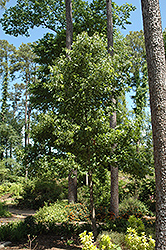It's all about ...
plants

Height: 95 feet
Spread: 50 feet
Sunlight:
![]()
Hardiness Zone: 6b
Other Names: Red Oak
Description:
With bark that is similar to the black cherry, this variety is a fast growing, tall oak with beautiful pagoda like leaves that are glossy deep green; a stately tree for the sunny landscape that is quite adaptable
Ornamental Features
Cherrybark Oak is primarily valued in the landscape for its ornamental upright and spreading habit of growth. It has dark green foliage with light green undersides. The glossy lobed leaves turn an outstanding red in the fall. It produces brown acorns in mid summer. The fruit can be messy if allowed to drop on the lawn or walkways, and may require occasional clean-up. The furrowed gray bark adds an interesting dimension to the landscape.
Landscape Attributes
Cherrybark Oak is a deciduous tree with an upright spreading habit of growth. Its average texture blends into the landscape, but can be balanced by one or two finer or coarser trees or shrubs for an effective composition.
This tree will require occasional maintenance and upkeep, and is best pruned in late winter once the threat of extreme cold has passed. It is a good choice for attracting birds and squirrels to your yard. Gardeners should be aware of the following characteristic(s) that may warrant special consideration;
- Messy
Cherrybark Oak is recommended for the following landscape applications;
- Shade
- Vertical Accent
Planting & Growing
Cherrybark Oak will grow to be about 95 feet tall at maturity, with a spread of 50 feet. It has a high canopy with a typical clearance of 7 feet from the ground, and should not be planted underneath power lines. As it matures, the lower branches of this tree can be strategically removed to create a high enough canopy to support unobstructed human traffic underneath. It grows at a fast rate, and under ideal conditions can be expected to live to a ripe old age of 300 years or more; think of this as a heritage tree for future generations!
This tree should only be grown in full sunlight. It prefers to grow in average to moist conditions, and shouldn't be allowed to dry out. It is not particular as to soil type or pH. It is highly tolerant of urban pollution and will even thrive in inner city environments. This species is native to parts of North America.
This plant is not reliably hardy in our region, and certain restrictions may apply; contact the store for more information.

